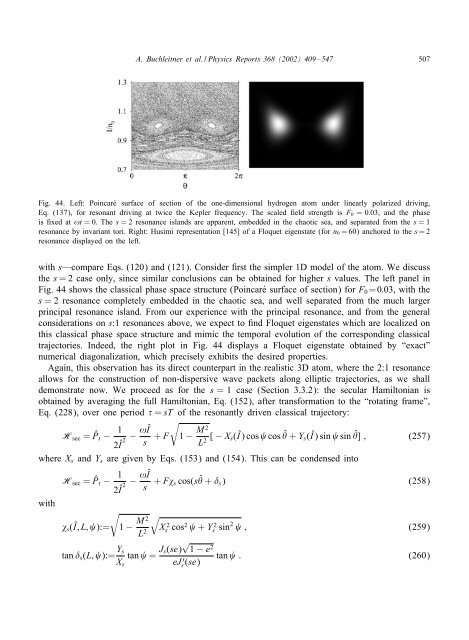Non-dispersive wave packets in periodically driven quantum systems
Non-dispersive wave packets in periodically driven quantum systems
Non-dispersive wave packets in periodically driven quantum systems
You also want an ePaper? Increase the reach of your titles
YUMPU automatically turns print PDFs into web optimized ePapers that Google loves.
A. Buchleitner et al. / Physics Reports 368 (2002) 409–547 507<br />
Fig. 44. Left: Po<strong>in</strong>care surface of section of the one-dimensional hydrogen atom under l<strong>in</strong>early polarized driv<strong>in</strong>g,<br />
Eq. (137), for resonant driv<strong>in</strong>g at twice the Kepler frequency. The scaled eld strength is F0 =0:03, and the phase<br />
is xed at !t =0: The s = 2 resonance islands are apparent, embedded <strong>in</strong> the chaotic sea, and separated from the s =1<br />
resonance by <strong>in</strong>variant tori. Right: Husimi representation [145] of a Floquet eigenstate (for n0 = 60) anchored to the s =2<br />
resonance displayed on the left.<br />
with s—compare Eqs. (120) and (121). Consider rst the simpler 1D model of the atom. We discuss<br />
the s = 2 case only, s<strong>in</strong>ce similar conclusions can be obta<strong>in</strong>ed for higher s values. The left panel <strong>in</strong><br />
Fig. 44 shows the classical phase space structure (Po<strong>in</strong>care surface of section) for F0 =0:03, with the<br />
s = 2 resonance completely embedded <strong>in</strong> the chaotic sea, and well separated from the much larger<br />
pr<strong>in</strong>cipal resonance island. From our experience with the pr<strong>in</strong>cipal resonance, and from the general<br />
considerations on s:1 resonances above, we expect to nd Floquet eigenstates which are localized on<br />
this classical phase space structure and mimic the temporal evolution of the correspond<strong>in</strong>g classical<br />
trajectories. Indeed, the right plot <strong>in</strong> Fig. 44 displays a Floquet eigenstate obta<strong>in</strong>ed by “exact”<br />
numerical diagonalization, which precisely exhibits the desired properties.<br />
Aga<strong>in</strong>, this observation has its direct counterpart <strong>in</strong> the realistic 3D atom, where the 2:1 resonance<br />
allows for the construction of non-<strong>dispersive</strong> <strong>wave</strong> <strong>packets</strong> along elliptic trajectories, as we shall<br />
demonstrate now. We proceed as for the s = 1 case (Section 3.3.2): the secular Hamiltonian is<br />
obta<strong>in</strong>ed by averag<strong>in</strong>g the full Hamiltonian, Eq. (152), after transformation to the “rotat<strong>in</strong>g frame”,<br />
Eq. (228), over one period = sT of the resonantly <strong>driven</strong> classical trajectory:<br />
Hsec = ˆPt − 1<br />
<br />
!Î<br />
− + F 1 − 2<br />
2Î s<br />
M 2<br />
L 2 [ − Xs(Î) cos cos ˆ + Ys(Î) s<strong>in</strong> s<strong>in</strong> ˆ ] ; (257)<br />
where Xs and Ys are given by Eqs. (153) and (154). This can be condensed <strong>in</strong>to<br />
with<br />
Hsec = ˆPt − 1 !Î<br />
− 2<br />
2Î s + F s cos(s ˆ + s) (258)<br />
<br />
s(Î; L; ):= 1 −<br />
tan s(L; ):= Ys<br />
Xs<br />
M 2<br />
L2 <br />
X 2<br />
s cos2 + Y 2<br />
s s<strong>in</strong> 2 ; (259)<br />
tan = Js(se) √ 1 − e 2<br />
eJ ′ s(se)<br />
tan : (260)











